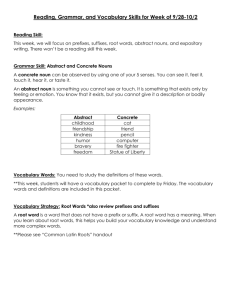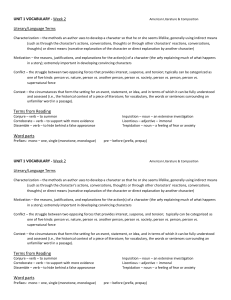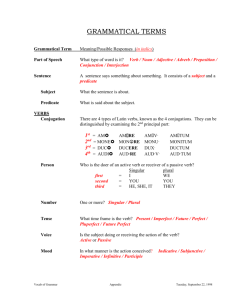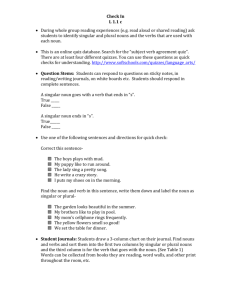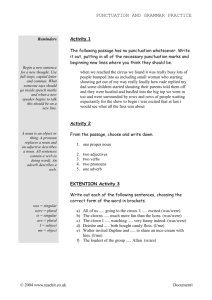Noun classes, prefixes and stems
advertisement
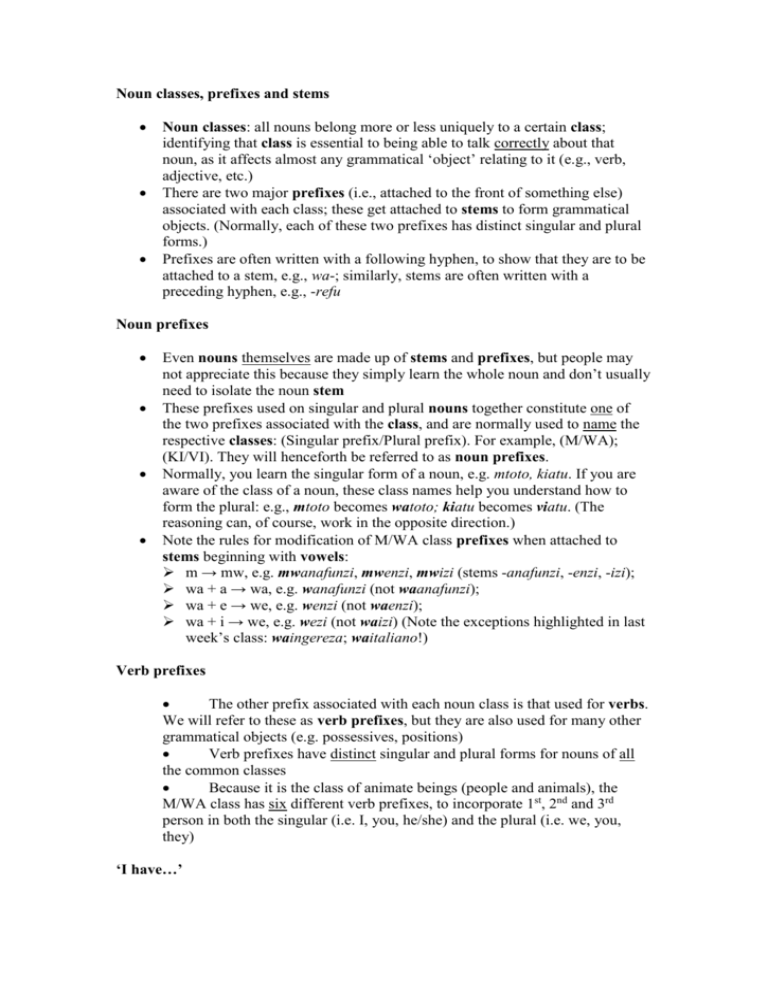
Noun classes, prefixes and stems Noun classes: all nouns belong more or less uniquely to a certain class; identifying that class is essential to being able to talk correctly about that noun, as it affects almost any grammatical ‘object’ relating to it (e.g., verb, adjective, etc.) There are two major prefixes (i.e., attached to the front of something else) associated with each class; these get attached to stems to form grammatical objects. (Normally, each of these two prefixes has distinct singular and plural forms.) Prefixes are often written with a following hyphen, to show that they are to be attached to a stem, e.g., wa-; similarly, stems are often written with a preceding hyphen, e.g., -refu Noun prefixes Even nouns themselves are made up of stems and prefixes, but people may not appreciate this because they simply learn the whole noun and don’t usually need to isolate the noun stem These prefixes used on singular and plural nouns together constitute one of the two prefixes associated with the class, and are normally used to name the respective classes: (Singular prefix/Plural prefix). For example, (M/WA); (KI/VI). They will henceforth be referred to as noun prefixes. Normally, you learn the singular form of a noun, e.g. mtoto, kiatu. If you are aware of the class of a noun, these class names help you understand how to form the plural: e.g., mtoto becomes watoto; kiatu becomes viatu. (The reasoning can, of course, work in the opposite direction.) Note the rules for modification of M/WA class prefixes when attached to stems beginning with vowels: m → mw, e.g. mwanafunzi, mwenzi, mwizi (stems -anafunzi, -enzi, -izi); wa + a → wa, e.g. wanafunzi (not waanafunzi); wa + e → we, e.g. wenzi (not waenzi); wa + i → we, e.g. wezi (not waizi) (Note the exceptions highlighted in last week’s class: waingereza; waitaliano!) Verb prefixes The other prefix associated with each noun class is that used for verbs. We will refer to these as verb prefixes, but they are also used for many other grammatical objects (e.g. possessives, positions) Verb prefixes have distinct singular and plural forms for nouns of all the common classes Because it is the class of animate beings (people and animals), the M/WA class has six different verb prefixes, to incorporate 1st, 2nd and 3rd person in both the singular (i.e. I, you, he/she) and the plural (i.e. we, you, they) ‘I have…’ The present tense of the verb ‘to have’ is the simplest verb in Swahili (except for the present tense of 'to be'). The stem to which the verb prefixes are attached is simply -na. In the M/WA class: nina nywele nzuri – I have nice hair una nywele nzuri – you have nice hair ana nywele nzuri – he/she has nice hair tuna nywele nzuri – we have nice hair mna nywele nzuri – you (both/all) have nice hair wana nywele nzuri – they have nice hair Note the following points, which distinguish Swahili from English grammar: There is no gender (male/female) distinction of any kind in Swahili grammar, i.e ‘he’ and ‘she’ (and later ‘him’, ‘her’, etc.) are expressed in exactly the same way ‘You’ (2nd person) has distinct forms for singular and plural. (The plural prefix, m-, is pronounced as a syllable of its own, taking stress.) The verb stem (in this case -na) never varies depending on who or what is being talked about (or when), because changes in prefix (or infix) are used for variations of person, tense etc. (Any change to a verb stem would change the entire meaning of the verb.) An important aside… While many words for animate beings are in the M/WA class, there are plenty which are not (e.g. baba, kiongozi, mbwa, bibi, etc.) ANY other grammatical objects (e.g. adjectives, quantities, verbs, etc.) used with nouns for animate beings treat them as if they were in the M/WA class (even if they are not). That is, they use the verb and noun prefixes of the M/WA class in all contexts (EXCEPT in pluralising the nouns, e.g. viongozi (not waongozi) and for N-class animate possessives) Finally, we draw up a table of the prefixes, which can be added to whenever you learn a new noun class: Class name M/WA Noun prefixes Singular Plural mwa- Verb prefixes Singular Plural ni-, u-, a- tu-, m-, wa- Remember that the noun prefixes are usually used to name the class.
